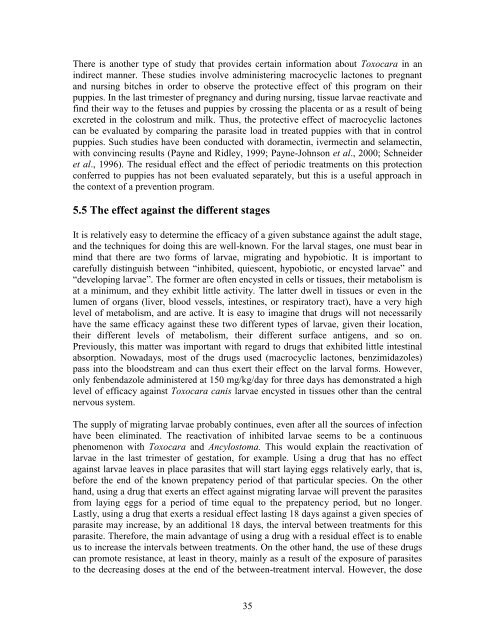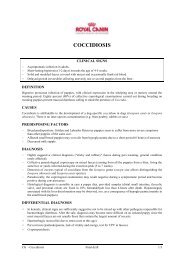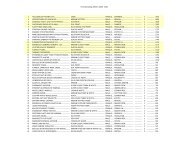Guide to Preventing Parasites.pdf - Royal Canin Canada
Guide to Preventing Parasites.pdf - Royal Canin Canada
Guide to Preventing Parasites.pdf - Royal Canin Canada
You also want an ePaper? Increase the reach of your titles
YUMPU automatically turns print PDFs into web optimized ePapers that Google loves.
There is another type of study that provides certain information about Toxocara in an<br />
indirect manner. These studies involve administering macrocyclic lac<strong>to</strong>nes <strong>to</strong> pregnant<br />
and nursing bitches in order <strong>to</strong> observe the protective effect of this program on their<br />
puppies. In the last trimester of pregnancy and during nursing, tissue larvae reactivate and<br />
find their way <strong>to</strong> the fetuses and puppies by crossing the placenta or as a result of being<br />
excreted in the colostrum and milk. Thus, the protective effect of macrocyclic lac<strong>to</strong>nes<br />
can be evaluated by comparing the parasite load in treated puppies with that in control<br />
puppies. Such studies have been conducted with doramectin, ivermectin and selamectin,<br />
with convincing results (Payne and Ridley, 1999; Payne-Johnson et al., 2000; Schneider<br />
et al., 1996). The residual effect and the effect of periodic treatments on this protection<br />
conferred <strong>to</strong> puppies has not been evaluated separately, but this is a useful approach in<br />
the context of a prevention program.<br />
5.5 The effect against the different stages<br />
It is relatively easy <strong>to</strong> determine the efficacy of a given substance against the adult stage,<br />
and the techniques for doing this are well-known. For the larval stages, one must bear in<br />
mind that there are two forms of larvae, migrating and hypobiotic. It is important <strong>to</strong><br />
carefully distinguish between “inhibited, quiescent, hypobiotic, or encysted larvae” and<br />
“developing larvae”. The former are often encysted in cells or tissues, their metabolism is<br />
at a minimum, and they exhibit little activity. The latter dwell in tissues or even in the<br />
lumen of organs (liver, blood vessels, intestines, or respira<strong>to</strong>ry tract), have a very high<br />
level of metabolism, and are active. It is easy <strong>to</strong> imagine that drugs will not necessarily<br />
have the same efficacy against these two different types of larvae, given their location,<br />
their different levels of metabolism, their different surface antigens, and so on.<br />
Previously, this matter was important with regard <strong>to</strong> drugs that exhibited little intestinal<br />
absorption. Nowadays, most of the drugs used (macrocyclic lac<strong>to</strong>nes, benzimidazoles)<br />
pass in<strong>to</strong> the bloodstream and can thus exert their effect on the larval forms. However,<br />
only fenbendazole administered at 150 mg/kg/day for three days has demonstrated a high<br />
level of efficacy against Toxocara canis larvae encysted in tissues other than the central<br />
nervous system.<br />
The supply of migrating larvae probably continues, even after all the sources of infection<br />
have been eliminated. The reactivation of inhibited larvae seems <strong>to</strong> be a continuous<br />
phenomenon with Toxocara and Ancylos<strong>to</strong>ma. This would explain the reactivation of<br />
larvae in the last trimester of gestation, for example. Using a drug that has no effect<br />
against larvae leaves in place parasites that will start laying eggs relatively early, that is,<br />
before the end of the known prepatency period of that particular species. On the other<br />
hand, using a drug that exerts an effect against migrating larvae will prevent the parasites<br />
from laying eggs for a period of time equal <strong>to</strong> the prepatency period, but no longer.<br />
Lastly, using a drug that exerts a residual effect lasting 18 days against a given species of<br />
parasite may increase, by an additional 18 days, the interval between treatments for this<br />
parasite. Therefore, the main advantage of using a drug with a residual effect is <strong>to</strong> enable<br />
us <strong>to</strong> increase the intervals between treatments. On the other hand, the use of these drugs<br />
can promote resistance, at least in theory, mainly as a result of the exposure of parasites<br />
<strong>to</strong> the decreasing doses at the end of the between-treatment interval. However, the dose<br />
35







